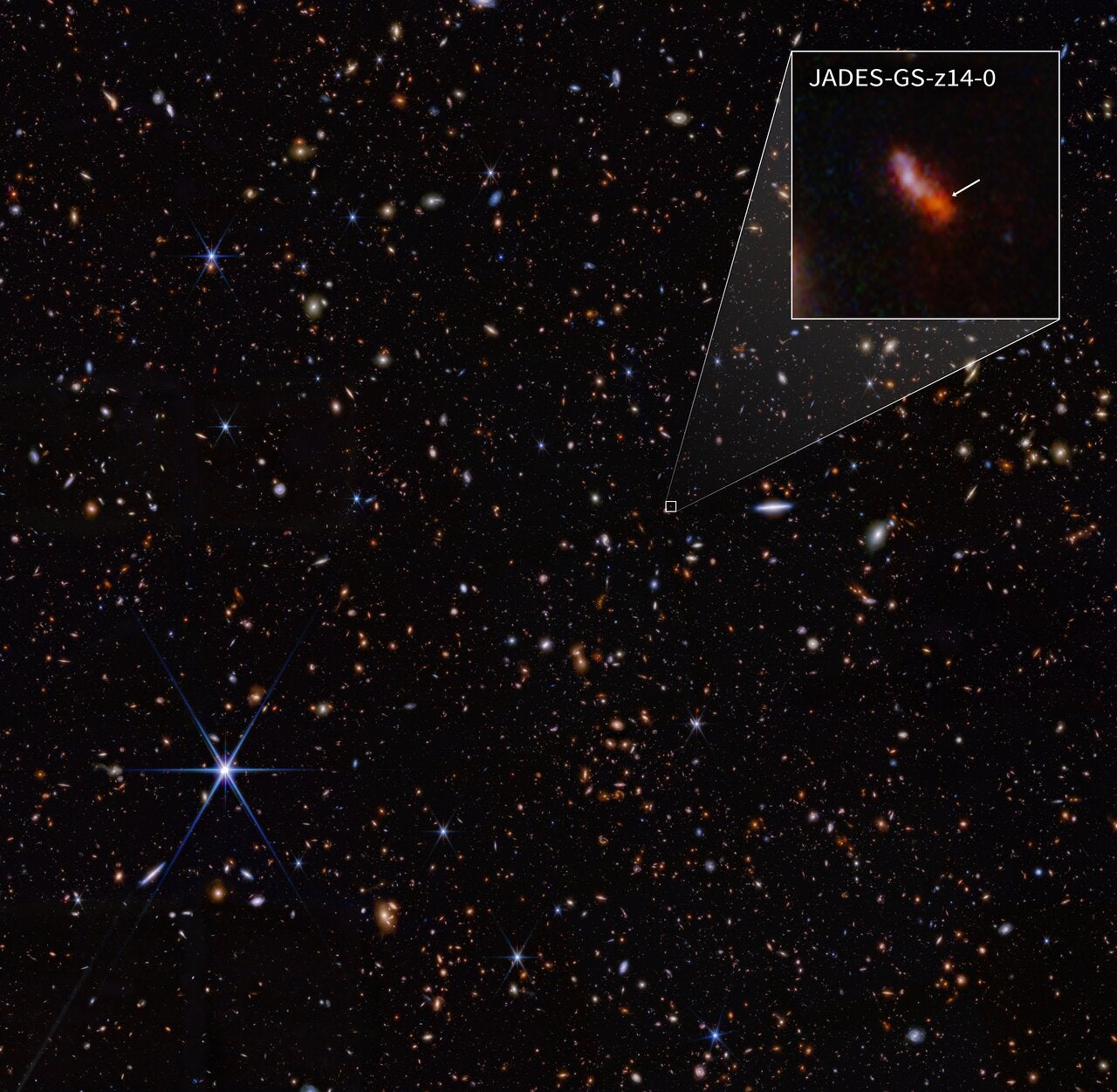
Not to sound like a broken record, but records are made to be broken. And the James Webb Space Telescope has just accomplished one. But researchers happily caution: as with all such records, it won’t stand forever.
JADES-GS-z14-0 is now the most distant—and, therefore, the youngest—galaxy ever observed. Formed just 290 million years after the Big Bang (at two percent of the age of the cosmos), the galaxy spans some 1,600 light-years and is pouring out light. The JWST Advanced Deep Extragalactic Survey (JADES) team announced the finding last week.
Measuring redshifts
Astronomers calculate distances to remote objects by measuring redshifts, a yardstick of how deeply stretched the galaxy’s light is (and redder means farther away). GS-z14-0 was discovered to have a redshift of 14.3, besting the 2022 record of a galaxy found with a redshift of 13.2 that corresponded to a formation age of some 325 million years after the Big Bang.
And GS-z14-0 is some five times more luminous than that prior most-distant galaxy, according to Kevin Hainline, a professor at the University of Arizona, who helped lead the discovery. “Nobody dreamed that there would be galaxies this bright at this high redshift,” says George Rieke, another University of Arizona astronomer who is the former deputy director of Steward Observatory.
According to NASA, members of the JADES team explained recently that “the light we see is coming mostly from young stars and not from emission near a growing supermassive black hole. This much starlight implies that the galaxy is several hundreds of millions of times the mass of the Sun! This raises the question: How can nature make such a bright, massive, and large galaxy in less than 300 million years?”
The galaxy is surprising for another reason, too. JADES researcher Jake Helton, also of the University of Arizona, identified an unexpected abundance of dust and emission lines from hydrogen and oxygen in the galaxy’s spectrum. The oxygen suggests that generations of massive stars have come and gone in the galaxy.
And there’s more.
The galaxy’s number of massive stars poses a dark-matter conundrum. Dark matter accumulates as the cosmos expands. Rieke says that “the problem with this galaxy is it’s pushing against what we think is the maximum mass for a dark halo at that time.”
The findings were made with JWST’s Near-Infrared Spectrograph, Near-Infrared Camera, and Mid-Infrared Instrument. In the latter case, researchers noted the irony that during the budget woes of JWST, the Mid-Infrared Instrument was frequently targeted for budget cuts. Now, along with its companion science packages, it’s targeting the earliest galaxies in the cosmos.

A puzzling galaxy
The findings from GS-z14-0 did not come easy. The team first observed the object more than a year ago, but its brightness and proximity to another galaxy was puzzling. While they had a preliminary redshift finding, the team later obtained a spectrum that confirmed the galaxy’s distance, along with its other puzzling properties, measurements that push but do not overturn models of stellar and galactic formation. The “naïve assumption,” said Helton, had been that these earlier galaxies would be smaller and fainter.
That’s why Hainline would go on to compare the finding to excavating a cellphone among ancient ruins in Rome because this galaxy is so much brighter than the previous record holder and seems more evolved in terms of composition.
Hainline and his colleagues were initially skeptical of the findings and later threw hands in the air with excitement. Hainline told Astronomy that the finding was “one of the weird great moments of my scientific career.” This is especially so because he recalls sleeping under a table during the Texas landfall of Hurricane Harvey. He was part of a skeleton crew left at NASA facilities to shepherd JWST during the storm. The GS-z14-0 discovery reminds him, he stresses, of the dedication of everyone who made the Webb Telescope and its ongoing findings possible.
Certainly JADES-GS-z14-0 won’t be the record-holder forever. As time rolls on, astronomers are destined to find even more distant, younger galaxies. Meanwhile, work from this discovery, including that of Brant Robertson, a University of California Santa Cruz astronomer, will be appearing in Astrophysical Journal and is being reviewed by Nature and Nature Astronomy.









